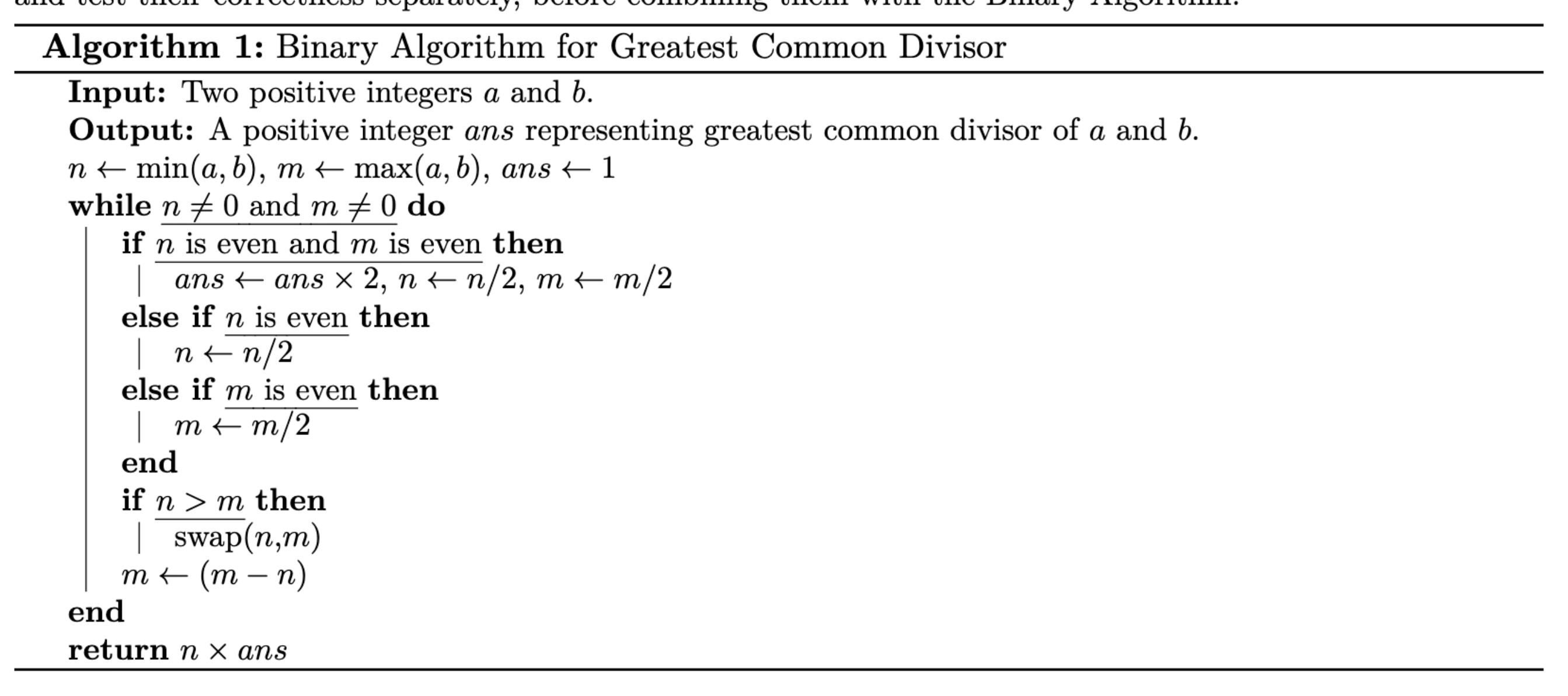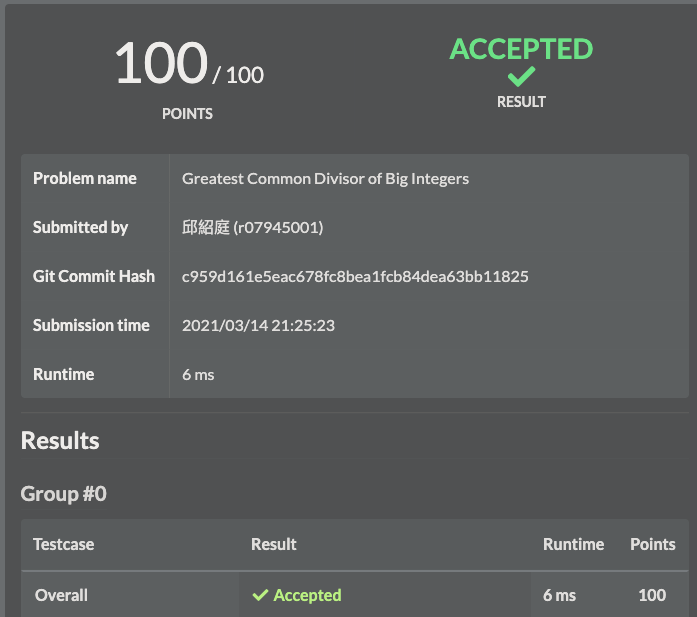Problem 1: Greatest Common Divisor of Big Integers (Programming)
Binary Algorithm

Usage
Use keyboard to set up two numbers for GCD calculation (<= 256 digits for each)
make RUN
12 3
3
Prerequisite
See manual.
字元輸入 <tt>scanf</tt>
#include <stdio.h>
int main(void) {
int input;
printf("請輸入數字:");
scanf("%d", &input);
printf("你輸入的數字:%d\n", input);
return 0;
}
- 告知程式儲存資料的變數位址,為此,必須使用
&取址運算子 - **字元陣列名稱**本身就有**位址資訊**,故不用
&來取址
Memory Management
malloc, free, calloc 和 realloc 是 C 語言配置記憶體空間的方法.
- Stack
- > 到目前為止,變數建立後會配置記憶體空間,這類資源是配置在記憶體的堆疊區(Stack),生命週期侷限於**函式執行期間**,也就是函式執行過後,配置的空間就會自動清除。
- Heap
- > 若要將函式執行結果傳回,不能直接傳回這類被自動配置空間的位址,因為函式執行過後,該空間就會釋出,函式呼叫者後續若透過位址取用這些資源,會發生不可預期的結果,例如,不能直接將區域建立的變數位址或陣列位址傳回。
- > 然而程式運行後,資源之間的互用關係錯綜複雜,有些資源「無法預期」被使用的生命週期,因為無法預期,也就有賴於開發者自行管理記憶體資源,也就是開發者得自行在需要的時候配置記憶體,這些記憶體會被配置在堆積區(Heap),不會自動清除,開發者得在不使用資源時自行釋放記憶體。
範例
malloc: 配置空間但不回傳值- 配置一個
int大小的記憶體 ```c int p = malloc(sizeof(int)); ``` - Array ```c ptr = (float) malloc(100 * sizeof(float)); ``` > The above statement allocates 400 bytes of memory. It's because the size of float is 4 bytes. And, the pointer ptr holds the address of the first byte in the allocated memory.
- 配置一個
calloc: 配置空間與初始值 ```c int *p = calloc(1, sizeof(int)); ``-free: 釋放記憶體``c int *p = malloc(100); free(p); ```
Fill the array: <a href="https://www.geeksforgeeks.org/memset-c-example/"><tt>memset</tt> function</a>
int number[5];
memset(number, 0, sizeof(number)); //zero array
Division in English
![https://www.learnalberta.ca/content/memg/videos/Divisor02/Divisor02-poster.jpg]()
File IO
Read from a text file
#include <stdio.h>
#include <stdlib.h>
int main()
{
int num;
FILE *fptr;
if ((fptr = fopen("C:\\program.txt","r")) == NULL){
printf("Error! opening file");
// Program exits if the file pointer returns NULL.
exit(1);
}
fscanf(fptr,"%d", &num);
printf("Value of n=%d", num);
fclose(fptr);
return 0;
}
如何安全清除記憶體
當 heap 在釋放之前配置的記憶體時,並不一定會把這些釋放的記憶體直接還給系統,它通常會把這些釋放的記憶體先保留下來,等到程式接下來又需要配置動態記憶體時,再拿出來繼續使用。
記憶體重複釋放(Double Free)
char *name = (char*) malloc(...);
// ...
free(name); // First free
// ...
free(name); // Double free
當遇到別名的 pointer 時更難檢查.
- Double free 的解決方法
char *name = (char*) malloc(...);
// ...
free(name);
name = NULL;
- 避免資料外洩
char *name = (char*)malloc(...);
// ...
memset(name,0,sizeof(name));
free(name);
但會對效能造成負擔
Result

Remarks
- Fastest implementation in class is
2ms(mine:6ms) - @sosiristseng recommended to store [0, 9999] in one
Intto speed up the process. To say, merging the operation and exploiting the int data type can triple the speed.
Reference
- BigInt in C [gist]
- 簡明 C 語言入門教學. [link]
- Simple MakeFile Tutorial. [link]
- 單元測試 - acutest. [Github, C Example]
- 字元輸入
scanf. [blog] printf字元. [tutorial]- Memory Management
- Pointer 整理. [blog]
- Do not use sizeof for array parameters. [GreekforGeek]
Makefiletutorial. [tutorial]i++or++i. [web]- Free a struct. [[StackOverFlow](https://stackoverflow.com/questions/13590812/c-freeing-structs]]
- Pass an array to function. [issue] )]
- Flexible array in struct. [greekforgeek]
- Read text file. [Pragramiz, GreekforGeek]
- 如何安全清除記憶體
free. [Blog] - C language doesn't suuport nested function. [GreekforGeek]